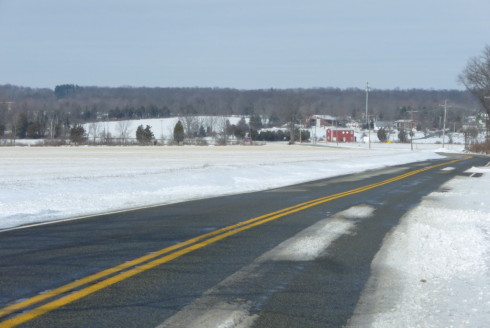We are getting some warmer days this weekend, and they are welcome after the very cold weather we’ve had lately. But cold as it was, it was nothing compared to the Blizzard of 1888, apparently the most intense weather ever experienced in Hunterdon County history. There are many stories and photographs depicting it, including this letter by Egbert T. Bush describing how he tried to defy it.
E. T. Bush
Articles by Egbert T. Bush published in the Hunterdon Democrat
When Stockton Was Not So Dry, part two
This part of Mr. Bush’s article deals primarily with the history of the tavern in Stockton, which began its life across the road from the Sharp-Lambert store (part one), but ended it as the Stockton Inn, at Bridge and Main Streets. (As usual, Mr. Bush’s article is in italics and my comments are not.)
When Stockton Was Not So Dry
Egbert T. Bush was very fond of grand old trees, and when they had to come down, he lamented the loss in his articles, including one that I published awhile ago, titled “Old Sentinel Oak Has Passed.” That huge tree, or as Bush would call it, a “Monarch,” once stood along Route 523 as you enter Stockton. Today’s article should have preceded “Old Sentinel Oak,” as it concerns the neighborhood of that great tree before it was taken down.
Working For Big Wages
In recognition of Labor Day this weekend I thought it would be interesting to see what labor was like when Egbert T. Bush was young. He would have been fifteen years old in 1863, during the Civil War. Since he was too young to be drafted, he was available to the neighborhood farmers who were short-handed, thanks to the war. His employer in those days left a big impression on the young man.
Requiem for a Monarch
Given that the Stockton Inn is now for sale, and a radical proposal for development of the site has been offered by the seller, I thought it would be appropriate to publish this article by Mr. Bush about a previous “improvement” to the Borough that took place not far from the Inn.
Ducks’ Flat
Ducks, A Vanished School, and The Dawn of the Space Age
“The ‘Oregon’ and Other Schools,” continued

With a name like Ducks’ Flat, you just know there must be a story there. But first, is it Duck’s Flat or Ducks’ Flat? I pitch for Ducks’, since it must have been a place where migrating ducks would gather. That’s the way Egbert T. Bush saw it. In his article “The ‘Oregon’ and Other Schools,” which I recently published in its entirety.1
Sergeant’s Mills, part four
This series of posts has been based on an article by Egbert T. Bush called “Sergeant’s Mills Once a Prosperous Place.” My previous post dealt with two of the four farms located in the Rosemont valley, on the north side of the road from Rittenhouse’s Tavern (Rosemont) to Skunk Town (Sergeantsville), otherwise known as Route 604. This post will describe the owner of the third farm, and include the rest of Mr. Bush’s article.
Sergeant’s Mills, part three
Being part three in a four-part post about an article written by Egbert T. Bush titled “Sergeant’s Mills Once a Prosperous Place” and published in the Hunterdon County Democrat on January 16, 1930.
Sergeant’s Mills, part two
After this article was published, some careful readers alerted me to a few errors which merit attention.
Sergeant’s Mills, part one
In a recent post on the life of John P. Rittenhouse, I mentioned that his parents, Samuel & Hannah Rittenhouse, lived near the covered bridge in Delaware Township. This reminded me of the interesting article written by Egbert T. Bush about the history of the area around Sergeant’s Mill.